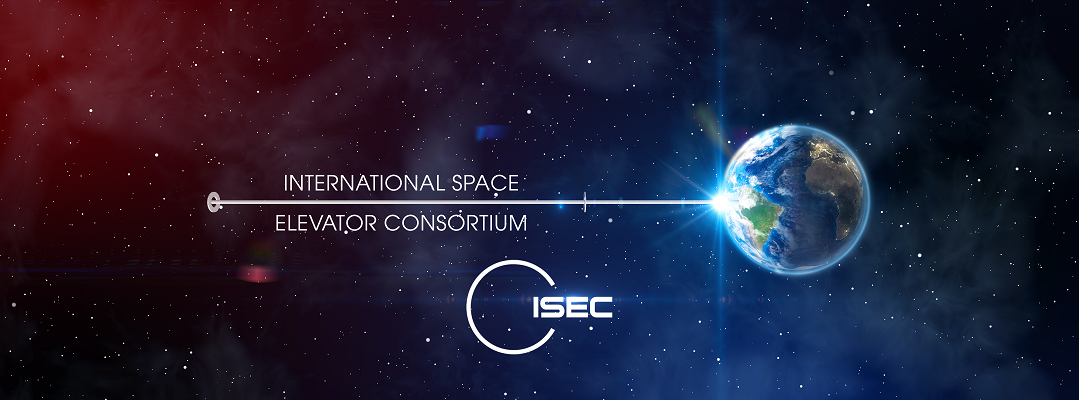Yuri Nikolaevich
Artsutanov
(1929-2019)
Introduction:
The
International Space Elevator Consortium (ISEC) recognizes the passing on 1
January, 2019 of “one of ours” and here we provide some personal remembrances
of his friends and colleagues in the West. Yuri Artsutanov was truly a giant
who contributed greatly towards our common dream - an operational space
elevator infrastructure. To set the stage of his contributions, this quote from
our First Issue of CLIMB, describes why he gave us an original concept:
"I
was interested in travelling into space from my early childhood. When I read
that a new super strong material had been invented I immediately realized it
could be used for building super long cables to lift us to cosmic altitudes,
i.e. for traveling into space."1
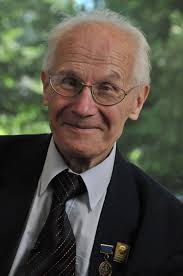
Yuri Artsutanov at the ISEC 2010 Conference
(image by Owen Kindig)
Part
One - Yuri Artsutanov's Place in Space Elevator History:
ISEC
is on a quest to provide a remarkable transportation infrastructure towards the
planets. Yuri Artsutanov is recognized as one of the great innovators in our
field. He took the thought experiment of Konstantin Tsiolkovsky [a compressive
structure from Earth to Geosynchronous altitude first outlined in 1895] to the
next level of development, a tether with tensile strength strong enough to
deploy from GEO to the Earth and upward towards the counterweight [i.e. Apex
Anchor]. Our history book, Space Elevators: A History, explained his place in
our history as such:
"Some
six decades after Tsiolkovsky, a young engineering student in Leningrad named
Yuri N. Artsutanov, came up with a more feasible scheme for building a space
tower by using a geosynchronous satellite as the base from which to construct
it. By using a counterweight, a cable would be lowered from geosynchronous
orbit to the surface of the Earth while the counterweight was extended from the
satellite away from Earth, keeping the center of gravity of the cable
motionless relative to Earth. Artsutanov, unaware at the time of Tsiolkovsky’s
castle 65 years prior, independently conceived of what he called a ‘cosmic
railway,’ the catalyst for which was an advancement in materials science that
had recently been made in the United States. His article was published in the
daily Russian tabloid Komsomolskaya Pravda on 31 July 1960. His piece, “To the
Cosmos by Electric Locomotive”,3 went into extensive detail
regarding what is thought to be yet another earlier rendition of a space
elevator (Artsutanov, 1960).
Artsutanov’s
elaborate engineering approach was sufficient to later label him as one of two
independent co-inventors of the space elevator. And though his ideas were
lacking in any kind of mathematical treatment, his thought processes included
enough conceptual detail to have him recognized as one of the space elevator’s
founding fathers, along with Jerome Pearson."2
One
intriguing fact about his contributions to the space elevator arena is that
there is a unit of measure named after him. The "Yuri" has been
recognized as a unit defining the Specific Strength of a material. This
specifies not only the stress inside a material, but stress divided by the
density allowing us to understand the ultimate stress acceptable with the mass
of the material which is important when you are measuring against a force such
as gravity. It is convenient to measure strength in GPa and density in g/cc,
and so the everyday unit used is GPa-cc/g, which is equal to 1E6
Pascal/(kg/m3). Thus: 1 Yuri = 1 (m/s)2,
and 1 Mega-Yuri = 1 N/Tex = 1 GPa-cc/g.4 The estimate for tether
material for the space elevator is that we need greater than 30 Mega-Yuri for
the material specific strength.
Part
Two - 2010 Space Elevator Conference:
by
Ted Semon (past president of the International Space Elevator Consortium and
Editor of CLIMB Journal and Via Ad Astra)
The
2010 Space Elevator Conference was held on August 13-15 at the Microsoft
Conference Center in Redmond, Washington. It was held under the auspices of the
Space Engineering and Science Institute (SESI) and co-sponsored by Microsoft
and ISEC. The highlight of the conference was the joint appearance of Yuri
Artsutanov and Jerome Pearson, the co-inventors of the modern-day concept of
the space elevator. The backstory of how Yuri and Jerome came to attend the
conference is a complicated one and started in 2008. It began with the ISEC
Board of Directors coming up with a plan to increase ISEC’s membership levels.
As part of this plan, ISEC asked Jerome if he would be willing to autograph
some space elevator-related material or memorabilia to be given to high-level
members and to also contact Yuri and ask him if he would be willing to do the
same (Jerome had already met Yuri during a previous trip to Russia in August
2006). We were delighted when they both said “Yes”. But then a better idea
appeared; Tom Nugent (of LaserMotive fame) suggested that ISEC sponsor a
competition to encourage academic and scientific research into topics related
to constructing and operating a space elevator. After much internal discussion,
ISEC decided in early 2010 to contact Jerome and Yuri to see if they would be
willing to lend their names to two separate competitions, one for students and
one for professionals. Again, they both immediately said “Yes” and the
Artsutanov and Pearson Prizes were born. Requirements to compete in the
competition were published in March 2010 and the 2010 Conference in August was
the first one where papers submitted for the competitions would be considered
for the award. As papers started coming in, ISEC then made the decision to
invite both Yuri and Jerome to the 2010 conference to present the awards in
person to any potential winners. And the fact that the conference was being
held in the same year as the 50-year anniversary of the publication of Yuri’s
initial paper on the space elevator (To the Cosmos by Electric Locomotive,
published July 31, 1960 in the Youth section of Komsomolskaya Pravda3) seemed
serendipitous indeed. Again, both Jerome and Yuri said “Yes” to the invitations
and then attention turned to how to make this all happen.
The
logistics necessary to have Jerome attend were relatively easy to navigate. He
was in the same country, he didn’t need a passport or travel permits and he
didn’t need an interpreter either. He just had to make sure his schedule was
clear, book his flights and that would be that. The situation with Yuri was
more complicated. His passport had expired, and he needed to apply for a new
one. He needed an interpreter at the conference as his English was almost
non-existent and he needed a travel companion as he was getting on in years. At
first it was going to be his son, Nicholas. However, it was later decided that
a relative of his living in Australia, Mr. Eugene Schlusser, would both
accompany Yuri and act as his translator. With that issue settled, ISEC then
sent a Letter of Invitation to Yuri that he could take to his local Consul’s
office in order to apply for his travel permits. In this Letter, we had to have
the “correct” English-language spelling of his name (Юрий Арцутанов) that the
Russian authorities would recognize. The first Letter of Invitation we sent
(via mail) never arrived so we sent a second one via Federal Express - this one
made it. Jerome also faxed a Letter of Invitation to the Consul and eventually
Yuri was able to get his travel papers. But then another problem occurred - the
actual timing of the conference. While we wanted to hold the conference on Aug
13-15, we were unsure if Microsoft would be able to sponsor the conference that
year. Their accounting year runs from July through June and the timing of the
conference made it difficult to know if sponsorship funds would be allocated
for their coming fiscal year. After some nervous weeks, everything all worked
out, Conference arrangements and travel arrangements were finalized, and Yuri,
Eugene and Jerome arrived at SeaTac airport on the afternoon of Thursday,
August 12th.
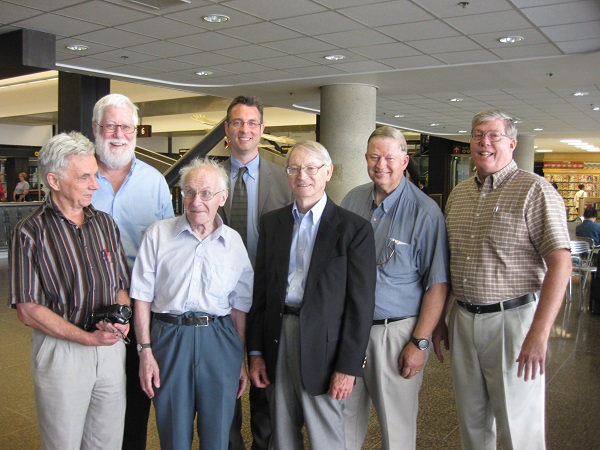
Airport Pickup of Yuri and Jerome. [L to R - Eugene
Schlusser, Pete Swan, Yuri Artsutanov, Michael Laine, Jerome Pearson, John Lee,
Ted Semon.] (Image by Owen Kindig)
ISEC
had issued a Press Release announcing their arrival and a local news outlet
sent a cameraman to SeaTac to film the event. ISEC had also hired a
photographer/videographer and he, too, was there to record the scene. Dr. Peter
Swan, the current president of ISEC, Michael Laine (LiftPort) and John Lee
(JPL) were with me at SeaTac to greet Yuri, Eugene and Jerome. It’s hard to
describe how excited I was to meet Yuri and Jerome. These were the two who had
laid the groundwork for the effort to build a space elevator, the very idea
that ISEC was founded upon. ISEC was the catalyst that made their trip to the
conference happen and to finally meet Yuri and Jerome upon their arrival was a
very special moment for all of us who met them at the airport.
As
can be well imagined, having Yuri and Jerome attend the conference was a great
success. And even though Yuri and Eugene suffered from jet-lag, they were
unfailingly engaged, gracious and just a joy to be around. Yuri clearly enjoyed
the moment - being among people who all bought into his vision and were working
to make it a reality. Several moments from the conference stand out:
On Friday morning, Jerome gave the
conference Keynote speech which described his EDDE proposal to NASA: “Space
Debris Mitigation Keynote: Enhancing Space Elevator Safety by Active Debris
Removal”. Later that same day there was an all-conference-attendees workshop on
the same subject. You can learn more about EDDE by reading Jerome’s same-titled
article found in Volume 1 of CLIMB.1
That same evening, the annual Strong
Tether Challenge, part of the NASA Centennial Challenges/Space Elevator Games,
was held and both Yuri and Jerome were in attendance. Sadly, as with the
previous (and subsequent) strong tether competitions, none of the materials
submitted proved to be as strong as conventional materials, let alone strong
enough to build a space elevator. In a comical moment, Yuri, clearly
disappointed in the results, offered to submit his tie as an entry!
Andy
Petro, the NASA coordinator of the Centennial Challenges/Space Elevator Games
at that time, was in attendance in case any of the entries met NASA’s
prize-winning criteria and so he and Yuri were able to meet. More information
about the NASA Centennial Challenges/Space Elevator Games can be found in the
article “A Brief History of the Space Elevator Games” contained in Volume 1 of Via
Ad Astra,5 as well as in the Space Elevators: A History book.2
The Saturday session started off
with an hour-and-a-half long Q&A session with both Yuri and Jerome. It was
fascinating to listen to them answering questions about how they had
independently come up with the idea of a tensile-based structure and other
questions submitted to them by the conference attendees and organizers. It’s
hard to imagine now, but when their articles were published in the 1960’s and
1970’s, there was no Internet available to research the work of others. The
Cold War was also in full-swing at that time and cooperation and information
sharing between Russian and American academics and scientists was minimal.
Listening to these two opine on all topics space elevator was indeed a treat.
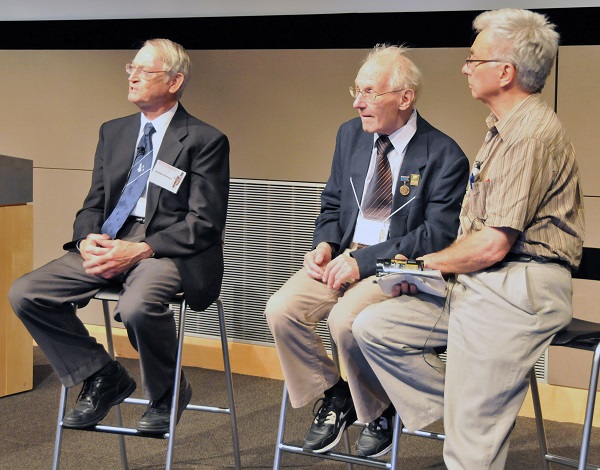
Q&A Session [L to R - Jerome Pearson, Yuri Artsutanov,
Eugene Schlusser] (Image by Owen Kindig)
There
were no winners declared for the Artsutanov and Pearson prizes, but one paper
was submitted which was deemed good enough to be awarded an Honorable Mention
for the Artsutanov Prize. The paper, “Seven Deadly Assumptions about the Space
Elevator”, was submitted by Gaylen Hinton. In an award ceremony on Saturday
afternoon, Yuri presented the Honorable Mention Certificate to Gaylen and
congratulated him on his efforts. After the conference was over, a second
Honorable Mention was awarded to Ghazaryan, Ambartsumian and Belubekyan for
their paper “Optimal Design of the Space Elevator Tether”.
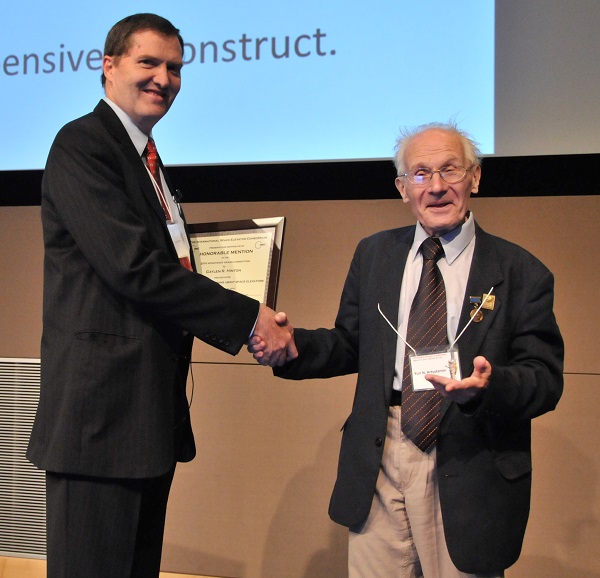
Gaylen Hinton receives Honorable Mention from Yuri (Image by Owen
Kindig)
We
are indeed fortunate to have an English-language translation of Yuri’s original
1960 paper. The person responsible for the translation, Roger Gilbertson, had
never met Yuri- the translation work had all been handled via correspondence.
Roger was able to attend this conference and so meet Yuri for the first time,
something that ISEC was happy to facilitate. During one of the conference
breaks, they sat down together, reviewing the original paper and translation,
with Yuri making some minor corrections along the way. It was a very photogenic
moment. A reprint of Yuri’s original paper and the English-language translation
are in Roger’s article “Finding and Translating Artsutanov’s Original Space
Elevator Article in 1960” which you can find in Volume 1, No 1 of CLIMB.1
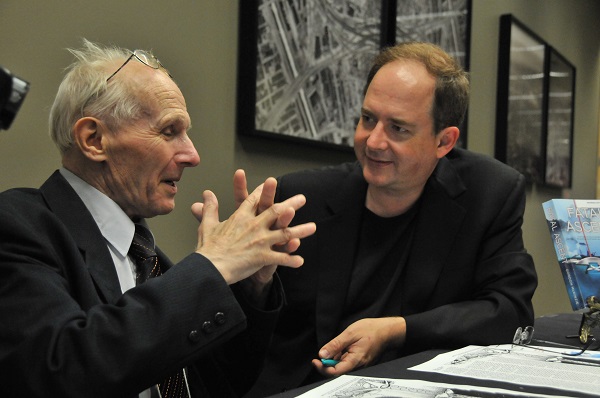
Yuri with Roger Gilbertson (Image by Owen Kindig)
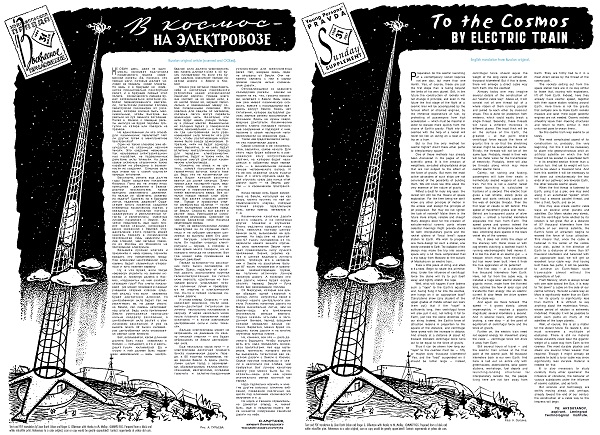
Higher
quality images of these articles can be found at Roger’s website following this
link:
<http://digitaltimewarp.com/Writing/Entries/2005/11/18_Entry_1_files/Artsutanov_Pravda_SE.pdf>
All
in all, the conference was a smashing success and all who attended will never
forget it. All of us who believe in the potential of the space elevator owe an
enormous debt of gratitude to both Yuri and Jerome and it is indeed fortunate
that they were able to attend the 2010 Space Elevator Conference and celebrate
the hope for the future with us.
Final
notes
Once the conference was over, Yuri
and Eugene spent several more days touring the USA before returning to Russia
and Australia respectively. During their journey, they were able to visit with
the renowned scientist, Dr. Freeman Dyson.
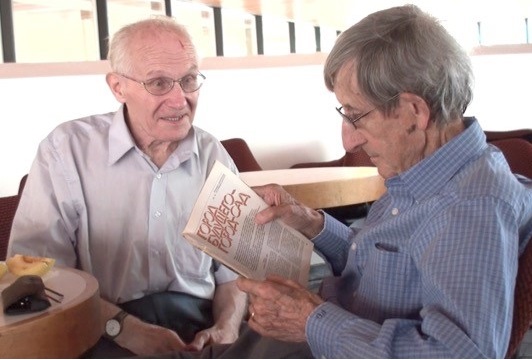
Yuri with Freeman Dyson (Image by Eugene Schlusser)
Shortly after the conference, Volume
1 of CLIMB was issued. It was dedicated to Yuri and a picture of him graces the
issue. He also wrote the Foreword for it.
(http://isec.org/wp-content/uploads/2017/05/CLIMB_Vol1No1_eVersion.pdf)
Volume 2 of CLIMB6 was
issued in 2013 and was dedicated to Jerome Pearson. A picture of him also
graces the issue and he wrote the Foreword for it. He also contributed the
article “The Real History of the Space Elevator.” Volume 2 also contains a
reprint of his 1978 paper, Lunar Anchored Satellite Test.
(http://isec.org/wp-content/uploads/2017/05/CLIMB_Vol2No1_eVersion.pdf)
More information about Yuri, his
life, his work and his academic passions can be found in the article
Conversations with Yuri Artsutanov published in Volume 1 of Via Ad Astra.
(http://isec.org/wp-content/uploads/2017/05/VAA_Vol1No1_rev0.pdf)
(All
issues of CLIMB and Via Ad Astra, as well as other ISEC publications, are
available as free pdfs from the ISEC website, www.isec.org)
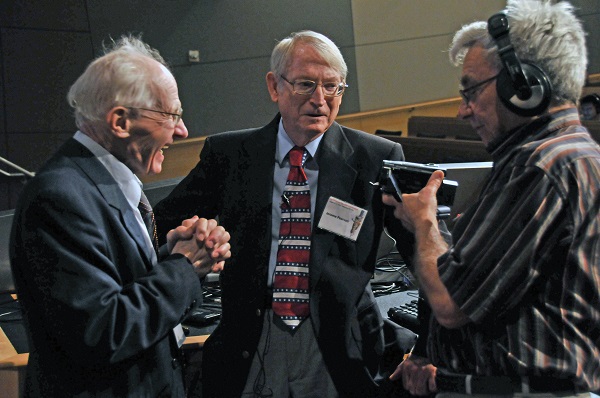
Yuri, Jerome Pearson, and Eugene Schlusser (Image by Owen Kindig)
Part
Three - Reflections from Jerome Pearson:
It
was with great sadness that I heard of the passing of Yuri Artsutanov this
month. Yuri was the first to propose an engineering concept of the space
elevator in 1960, in an article in Komsomoskaya Pravda3, long before my
independent discovery. He went on to propose the “rolling satellite” before
Hans Moravec came up with that idea, and published a paper on the lunar space
elevator a little more than a year after my paper.
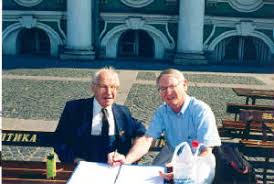
Yuri with Jerome Pearson in St. Petersburg
Yuri
and I first met when I visited him in St. Petersburg in August 2006. We met at
the Hermitage Museum, as shown here, and discussed space elevators through an
interpreter, because Yuri didn’t speak English, and I had forgotten all my
college Russian! We also shared some exciting moments when he was able to
attend the Space Elevator conference in 2010. Arthur Clarke visited Yuri in 1982,
as shown below.
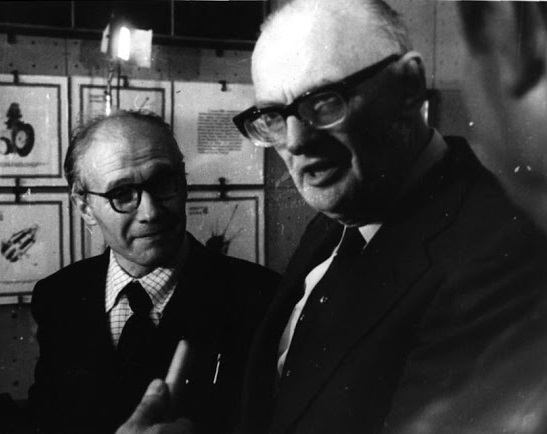
Yuri with Arthur C. Clarke
Yuri
was an artist as well as a space innovator. When I visited him, he gave me a
piece of his art, a glass swan, as shown below. He was a kind and gentle man, and he will be sorely missed. His wife
Ludmilla died several years ago, but he is survived by his son Nick.
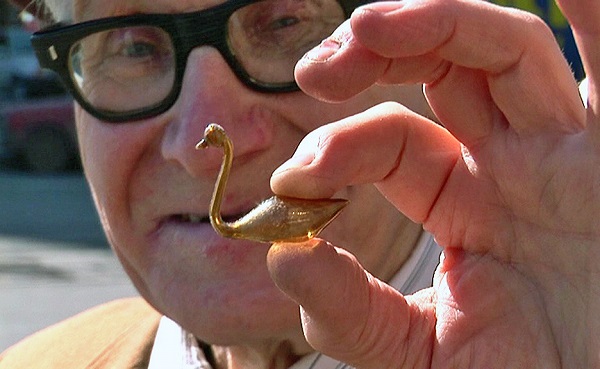
Yuri Artsutanov as an artist
Part
Four - A short summary of his Life:
Yuri
was born on Oct 5, 1929 in Leningrad. A graduate of Leningrad Technological
Institute specializing in complex chemistry, he was always a fan of high
technology developments across the spectrum of science. His parents were
teachers and he excelled throughout his academic career and professional work. He
lived during tumultuous times, starting with his escape from Leningrad across
the frozen lake in 1942. With his splendid academic performances, he ended up
in the Chemical Institute of the Leningrad Institute. From there he progressed
through medium level jobs in associated fields of work. He worked at VNIIASH
(Institute for Abrasives and Grinding Materials) from 1966 to 1992. However, it
was from 1957 to 1960 that his imagination and scientific curiosity led to the
story in "Komsomolskaya Pravda" in 1960 entitled “Into the Cosmos by
Electric Locomotive”. This article transitioned from a thought experiment by K.
E. Tsiolkovsky towards the more engineering-based concepts of Jerome Pearson. He
left the world with a challenge and hope for the future - continue his work and
develop a low-cost access to space transportation infrastructure which will
change the human condition.
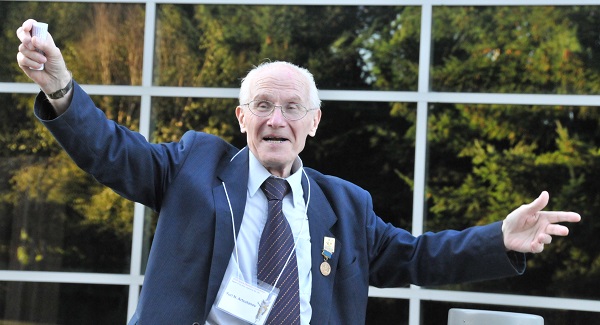
Yuri Artsutanov celebrating at the 2010 International Space
Elevator Conference (image by Owen Kindig)
Part Five - In his own words
Foreword to Climb--The Journal of the International Space
Elevator Consortium (ISEC), Vol 1 Number 1, December 2011
Contributed by Yuri Artsutanov, Translated by Eugene
Schlusser
When Arthur C. Clarke and I met in 1982, we still thought,
as he put it, the space elevator would be built 50 years after people stopped
laughing, in a couple of centuries or so.
So I am 'over the moon' to coin a phrase that the International Space
Elevator Consortium is bringing the reality of a Space Elevator much closer by
asking serious questions on how to solve the practical problems of: strength of
the tether, powering the elevator, minimizing space junk and many more. I was
the first to have written on this subject but as Clarke said it was an idea
whose time has come. Development will accelerate. But, we are only at the stage
James Watt was in the 1770s when he developed his steam engine. No one could
foresee what applications it would spawn and we can only speculate on the
future application of my space elevator idea. NASA is thinking of sending 20
people to Mars. They may build the first space elevator there, or on the moon,
or ....between the satellites of Jupiter. As Jerome Pearson has suggested, the
space elevator may play an important role in coping with climate change.
I was delighted to meet Jerome Pearson again, and make the
acquaintance of all the presenters and participants at the 2010ISECconference.
Jerome Pearson's proposal for reducing space junk is an interesting and vital
contribution to bring the construction of a space elevator closer. The optimism
of many of the other presenters was encouraging. The Annual space elevator
conference in Seattle, which I had the privilege of attending, brought forth
other questions. As we all know, asking the right questions is a vital step to
finding answers.
Building a space elevator will require global cooperation.
It has always been my hope that my idea might be a contribution to world peace,
bringing all nations together to solve the legal, technical and social issues
raised by realizing such a project. As I read in the last little while that
rivalry in space is increasing I urge all to find means of working together. We
all know of the possible dire consequences of unaccountable, uncontrolled
projects in space.
This publication is proof of the vitality of the debate in
many parts of the world. May readers be inspired by its content to help make
extensive space travel a reality, spurred on by Tsialkovski's thought that
mankind cannot stay in its cradle forever.
Yuri Artsutanov
August 2011
St Petersburg, Russia1
References:
1.
Semon, Ted. Editor (Dec 2011) CLIMB The Journal
of the International Space Elevator Consortium (ISEC), Vol 1, No 1
2.
Raitt, David, Space Elevators: A History, Lulu.com, ISEC Report 2017.
3.
Artsutanov, Y. (1960), "в космос на электровозе," Komsomolskaya
Pravda, 31 July 1960. (English translation “Into the cosmos by electric train”
by Joan Barth Urban and Roger G. Gilbertson, 2004, available at:
http://images.spaceref.com/docs/spaceelevator/Artsutanov_Pravda_SE.pdf .
Article also described in English by Vladimir Lvov in Science, Vol158, Issue
3803, pp 946-947, 1967.)
4.
Keith Curtis Wiki Page Retrieved January 29, 2019 from http://keithcu.com/wiki/index.php/Specific_Strength_in_Yuris
5.
Semon, Ted. Author (2015) A Brief History of The Space Elevator Games. Via Ad Astra The Space Elevator Magazine,
Vol 1, No 1
6. Pearson, Jerome (2013) The Real history of
the Space Elevator. CLIMB The Journal of
the International Space Elevator Consortium (ISEC), Vol 2, No 1, 75-83
7.
Artsutanov, Y., "Into the Cosmos without Rockets," Znanije-Sila 7,
25, 1969.
8. Artsutanov, Y., "Railway
‘Moon-Earth’," Technika Molodishi, No. 4, p. 21, 1979.
9.
Ramanujan (2016, December 2) la-problematica-del-ascensor-espacial Retrieved from http://ramanujan25449.blogspot.com/2016/12/la-problematica-del-ascensor-espacial.html
